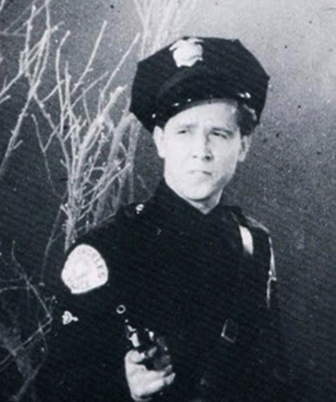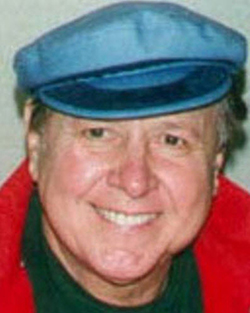|
|||||||||||||||||
November 2009 Web Edition Issue #3 |
|||||||||||||||||
| Mondo Cult Forum Blog News Mondo Girl Letters Photo Galleries Archives Back Issues Books Contact Us Features Film Index Interviews Legal Links Music Staff |
 Conrad Brooks in Plan 9 From Outer Space To Conrad Brooks, With Loveby Michael CopnerHere are some memories I cherish, about screen actor Conrad Brooks, and the impact he lavished on the early issues of Cult Movies magazine. Our little publication would never have taken the directions is did, unless we’d met Conrad. Other towering and talented persons made contributions which have never been disclosed—but their paths all crossed in our pages. Synchronicities do occur, perhaps more in film than Freud and Jung could imagine, because Hollywood is such a tightly knit community, all working within a few square miles. Lisa Mitchell was my neighbor in the Hollywood Hills from 1986 to 2001. As a little girl of 5, she’d seen Bela Lugosi often in his final years. She was fascinated and later befriended his son Bela, Jr. Lisa and I shared stories and favorite scenes from some of Lugosi’s films. From 1988 to 1990, my houseguest was Korla Pendit, keyboard master of television fame. After 10 years of seclusion in Vancouver, Canada, he’d returned to southern California in hopes of re-establishing his 1050s success in a new era of MTV and many low-power TV stations growing nationally. During his 2 year stay at my home, Korla developed a close relationship with Lisa. They were two who created the idea for the printed tribute, Bela Lugosi, Then and Now. Korla had originated the over-riding banner on that Lugosi book-a-zine: Videosonic Arts. It was a logical hybrid word, Video (sight) and Sonic (sound). We’d used it on a series of Korla’s concerts and meditation seminars at Manly Palmer Hall’s establishment, the Philosophical Research Society. It had a high-brow ring, so it got borrowed for this intended one-shot publication. It sold well, paved the way for Fantastic Television and the then planned end to a trilogy to be printed as Cult Movies. That’s when Conrad Brooks was introduced to me and everything revved up. I’d recently met Chuck Harter, a media expert on Superman, The Monkees and Bela. One day he told me, “I just met a guy who worked with Ed Wood and Lugosi. He’s been fairly silent about that period of his life, but he’s finally ready to talk. Want to drive over and meet him today?” The guy was Conrad and meeting him was a delight. Anyone meeting him might have wondered why Mr. Brooks had been shy and quiet about his Ed Wood years; for he loved to meet people and chat jovially. Fortunately for historians of unusual cinema, he was closely involved with the Ed Wood scene and had seemingly complete recall about Eddie’s films and novel writing. Conrad became a focal point of Cult Movies issues for several years. There likely would not have been a continuing series of magazines had it not been for his participation via articles by him and interviews with him pertaining to Wood and Lugosi, along with special tributes to actors such as his close friend Tor Johnson. One of a kind photos were loaned to our publication from Conrad’s scrapbooks. Reader response was enthusiastic, along with newsstand sales. This suggested the one-man-talk-show with Conrad which became On the Trail of Ed Wood. This Conrad video was hardly planned, it just happened in my living room as you see it. Its economical nature shines through, appearing much cheaper—say—than those early 20 sex-loops Eddie shot for Swedish Erotica. On the day of our shoot, I picked Conrad up at his nice apartment near the golf course at Griffith Park. Bringing the gentleman to my place in the Hollywood Hills, we walked up and down my street, deciding on 10 good questions to ask him on camera. There’s be no time for rehearsals or re-takes once we got upstairs; what you see now is entirely what happened in 1991.  L-R: Conrad Brooks and Tor Johnson During our walk we encountered my neighbor Betsy—outside, weeding her garden. The two conversed for 5 minutes at most, then Conrad and I went upstairs to shoot the video. After completion, I drove him back home. When I returned to my place, Betsy came running to my car with a burning question on her lips. Here was an educated, well-traveled lady who’d been a banker and a school teacher. In earlier days she’d been a cattle rancher. A woman who’d met hundreds of diverse people on life’s stage. Now she had but one thought: “who was that man you had over here just now?” I told her a few things about Conrad. Beaming, she confided, “That man has the firmest, warmest handshake I’ve received in my life. When he talks, he smiles and truly looks you in the eyes. There’s nothing fake about that man!” Film fans around America shared that feeling, as Conrad emerged more frequently at screenings and autograph shows. Having contacted 5 videotape and comic book distributors, the video sold well in stores. It sold well via mail order in our magazine for many years. It continues to be sold on DVD in stores nationally, even today. From the start, critics remarked on the economical nature of the movie, shot entirely on my video-8 camcorder. Likewise, they commented on the charisma of Conrad, his sincere nature and the value of the insider information he imparted on his career and work with Ed Wood. Never did Conrad offer up inflated, delusional hyperbole about Ed Wood. Neither did he parrot ad nauseam the “worst director, worst film” tripe invoked by so many. He recounted his personal friendship and filmmaking work with a true Hollywood original. By the way, I never felt Ed and his Plan 9 were the worst. In the 1990s, our friend Mike Vraney distributed through his company Something Weird Video, vintage films of a more inept quality than anything Wood helmed. One wonders if the re-emergence of Conrad Brooks in 1991, the new light he was casting on his pal Ed Wood, in any way influenced Tim Burton a few years later, to produce a bio film on Wood and Lugosi. Being friends with Conrad had a few minor price tags, but each one was a pleasure. From time to time he had me drive him to a casting call. One time he confided, “I used to do this for Eddie. There were many times he didn’t have any car at all.” Conrad would always introduce me to the casting agent, his way of paying back for the ride.  Connie, as I remember him from the 90s - Ed.. Just to check in on Ed and his wife Cathy, Conrad happened to drop in many times during a productive period, when Ed was writing erotic weird fiction for Pendulum Press. I was told by Conrad, “He’d write at lightening pace, usually first draft. No time for any re-writes! He felt he did his best writing in drag, so he’d get dressed up in women’s finery. The wig, make-up and blouse—but he’d seldom shave off the mustache. He might have a production meeting the next day and wanted to keep the ’stache.” He also revealed that the girl name for Ed was Shirley. As in a joke, “I surely would”. When Conrad left Hollywood, he returned to be with his wife Ruth and their daughter Connie. I never saw him after that. Though we spoke on the phone, we really lost track of each other. During our final talk, he said he’d been to the dentist two days previous. The experience was hellish, leaving him with missing teeth. In a videotaped interview in Conrad’s last years and posted on the internet, one can see that a few upper teeth are gone. He never bothered with implants or a partial plate. His teeth were all authentic—like the man himself. In the interview, he confesses that he came to Hollywood with no acting training, no particular plans to get into films. For such a one, his credits are vast, his impact on cinema impressive indeed. I was blessed to have known him for a few years. His achievements may well shine on theater and home video screens for generations to come.  Happy Days at the Fanex Convention in Towson, MD in 1993. | ||||||||||||||||




